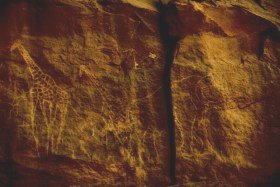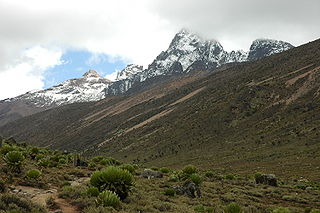This article relies largely or entirely on a single source .(March 2023) |
African pluvial periods are an obsolete system of climatic periods previously used by paleontologists working in East Africa.
This article relies largely or entirely on a single source .(March 2023) |
African pluvial periods are an obsolete system of climatic periods previously used by paleontologists working in East Africa.
The sedimentary deposits left by ancient lakes in East Africa had enabled Louis Leakey and post-war paleontologists to define major climatic periods considered wet, interspersed with drier periods. Of progressively decreasing durations, they each bore the name of the site where the first clues had been collected: Kageran (Kagera), Kamasian, Kanjeran (Kanjera) and Gamblian. Paleontologists believed that the quasi-arid zones then became wooded savannahs where animals and prehistoric hunter-gatherers could thrive.

These ancient climatic periods were only very approximately dated:
The Kageran takes its name from the Kagera River, which flows through Rwanda and northwestern Tanzania before flowing into Lake Victoria.
Kamasian is a district of Kenya located in the Great Rift Valley.
Kanjera is a site in Kenya located on the shores of Lake Victoria.
The term Gamblian was introduced by Louis Leakey in the 1930s.
These ancient climatic periods have been gradually replaced in the scientific literature by the isotopic chronology in force since the end of the 20th century, which defines the alternation of glacial and interglacial periods on a global scale. Interglacial periods are warmer and, therefore, wetter on average than ice ages. The latter, however, themselves experience alternations of more or less heavy rainfall, but at a much faster rate (on a geological scale) than what had originally been imagined for East Africa.[ citation needed ]

Louis Seymour Bazett Leakey was a Kenyan-British palaeoanthropologist and archaeologist whose work was important in demonstrating that humans evolved in Africa, particularly through discoveries made at Olduvai Gorge with his wife, fellow palaeoanthropologist Mary Leakey. Having established a programme of palaeoanthropological inquiry in eastern Africa, he also motivated many future generations to continue this scholarly work. Several members of the Leakey family became prominent scholars themselves.

The Pleistocene is the geological epoch that lasted from c. 2.58 million to 11,700 years ago, spanning the Earth's most recent period of repeated glaciations. Before a change was finally confirmed in 2009 by the International Union of Geological Sciences, the cutoff of the Pleistocene and the preceding Pliocene was regarded as being 1.806 million years Before Present (BP). Publications from earlier years may use either definition of the period. The end of the Pleistocene corresponds with the end of the last glacial period and also with the end of the Paleolithic age used in archaeology. The name is a combination of Ancient Greek πλεῖστος (pleîstos), meaning "most", and καινός, meaning "new".

The Stone Age was a broad prehistoric period during which stone was widely used to make stone tools with an edge, a point, or a percussion surface. The period lasted for roughly 3.4 million years and ended between 4,000 BC and 2,000 BC, with the advent of metalworking. Though some simple metalworking of malleable metals, particularly the use of gold and copper for purposes of ornamentation, was known in the Stone Age, it is the melting and smelting of copper that marks the end of the Stone Age. In Western Asia, this occurred by about 3,000 BC, when bronze became widespread. The term Bronze Age is used to describe the period that followed the Stone Age, as well as to describe cultures that had developed techniques and technologies for working copper alloys into tools, supplanting stone in many uses.

A pluvial lake is a body of water that accumulated in a basin because of a greater moisture availability resulting from changes in temperature and/or precipitation. These intervals of greater moisture availability are not always contemporaneous with glacial periods. Pluvial lakes are typically closed lakes that occupied endorheic basins. Pluvial lakes that have since evaporated and dried out may also be referred to as paleolakes.

The Last Glacial Period (LGP), also known colloquially as the Last Ice Age or simply Ice Age, occurred from the end of the Eemian to the end of the Younger Dryas, encompassing the period c. 115,000 – c. 11,700 years ago. The LGP is part of a larger sequence of glacial and interglacial periods known as the Quaternary glaciation which started around 2,588,000 years ago and is ongoing. The definition of the Quaternary as beginning 2.58 million years ago (Mya) is based on the formation of the Arctic ice cap. The Antarctic ice sheet began to form earlier, at about 34 Mya, in the mid-Cenozoic. The term Late Cenozoic Ice Age is used to include this early phase. The previous ice age, the Saale glaciation, which ended about 128,000 years ago, was more severe than the Last Glacial Period in some areas such as Britain, but less severe in others.

There have been five or six major ice ages in the history of Earth over the past 3 billion years. The Late Cenozoic Ice Age began 34 million years ago, its latest phase being the Quaternary glaciation, in progress since 2.58 million years ago.
The Yarmouthian stage and the Yarmouth Interglacial were part of a now obsolete geologic timescale of the early Quaternary of North America.

Paranthropus aethiopicus is an extinct species of robust australopithecine from the Late Pliocene to Early Pleistocene of East Africa about 2.7–2.3 million years ago. However, it is much debated whether or not Paranthropus is an invalid grouping and is synonymous with Australopithecus, so the species is also often classified as Australopithecus aethiopicus. Whatever the case, it is considered to have been the ancestor of the much more robust P. boisei. It is debated if P. aethiopicus should be subsumed under P. boisei, and the terms P. boisei sensu lato and P. boisei sensu stricto can be used to respectively include and exclude P. aethiopicus from P. boisei.

An interglacial period is a geological interval of warmer global average temperature lasting thousands of years that separates consecutive glacial periods within an ice age. The current Holocene interglacial began at the end of the Pleistocene, about 11,700 years ago.

The Quaternary glaciation, also known as the Pleistocene glaciation, is an alternating series of glacial and interglacial periods during the Quaternary period that began 2.58 Ma and is ongoing. Although geologists describe this entire period up to the present as an "ice age", in popular culture this term usually refers to the most recent glacial period, or to the Pleistocene epoch in general. Since Earth still has polar ice sheets, geologists consider the Quaternary glaciation to be ongoing, though currently in an interglacial period.

Glynn Llywelyn Isaac was a South African archaeologist who specialised in the very early prehistory of Africa, and was one of twin sons born to botanists William Edwyn Isaac and Frances Margaret Leighton. He has been called the most influential Africanist of the last half century, and his papers on human movement and behavior are still cited in studies a quarter of a century later.

The Sahara pump theory is a hypothesis that explains how flora and fauna migrated between Eurasia and Africa via a land bridge in the Levant region. It posits that extended periods of abundant rainfall lasting many thousands of years in Africa are associated with a "wet-green Sahara" phase, during which larger lakes and more rivers existed. This caused changes in the flora and fauna found in the area. Migration along the river corridor was halted when, during a desert phase 1.8–0.8 million years ago (mya), the Nile ceased to flow completely and possibly flowed only temporarily in other periods due to the geologic uplift of the Nile River region.
Hyrax Hill is a prehistoric site near Nakuru in the Rift Valley province of Kenya. It is a rocky spur roughly half a kilometer in length, with an elevation of 1,900 meters above sea level at its summit. The site was first discovered in 1926 by Louis Leakey during excavations at the nearby Nakuru Burial Site, and Mary Leakey conducted the first major excavations between 1937 and 1938. There are two distinct areas of occupation at Hyrax Hill: one which was occupied during the Pastoral Neolithic and late Iron Age, and one which was occupied by the Sirikwa earlier in the Iron Age.

The climate of Mount Kenya has played a critical role in the development of the mountain, influencing the topography and ecology amongst other factors. The area around Mount Kenya is covered by a comparably large number of weather station data with long measurements series and thus the climate is well recorded. It has a typical equatorial mountain climate which Hedberg described as winter every night and summer every day.
The Mousterian Pluvial is a mostly obsolete term for a prehistoric wet and rainy (pluvial) period in North Africa. It was described as beginning around 50,000 years before the present (BP), lasting roughly 20,000 years, and ending ca. 30,000 BP.
The prehistory of Southeastern Europe, defined roughly as the territory of the wider Southeast Europe covers the period from the Upper Paleolithic, beginning with the presence of Homo sapiens in the area some 44,000 years ago, until the appearance of the first written records in Classical Antiquity, in Greece as early as the 8th century BC.

Prehistory, also called pre-literary history, is the period of human history between the first known use of stone tools by hominins c. 3.3 million years ago and the beginning of recorded history with the invention of writing systems. The use of symbols, marks, and images appears very early among humans, but the earliest known writing systems appeared c. 5,000 years ago. It took thousands of years for writing systems to be widely adopted, with writing spreading to almost all cultures by the 19th century. The end of prehistory therefore came at very different times in different places, and the term is less often used in discussing societies where prehistory ended relatively recently.
Sonia Mary Cole was an English geologist, archaeologist, anthropologist and author.

Johanna Alida Coetzee was a researcher in the field of Palynology at the University of the Free State and a pioneer in the analysis of fossil pollen. Her DSc thesis received worldwide recognition and praise from the eminent glacial geologist Richard Foster Flint and helped recognise the significance of temperature changes in controlling shifts in global and local vegetation zones.

Lake Estancia was a lake formed in the Estancia Valley, central New Mexico, which left various coastal landforms in the valley. The lake was mostly fed by creek and groundwater from the Manzano Mountains, and fluctuated between freshwater stages and saltier stages. The lake had a diverse fauna, including cutthroat trout; they may have reached it during a possible past stage where it was overflowing.